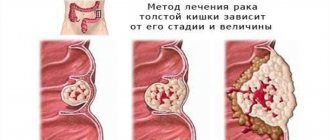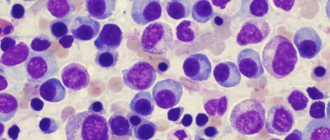In this article we will look at the first symptoms of throat cancer.
This is a very common pathology, however, it cannot be said that it is among the leaders among other malignant tumors. The incidence of this type of cancer is approximately 8%, and most often this tumor is found in older men, smokers and people suffering from frequent inflammation of the larynx. In women, this throat cancer is much less common.
What are the first symptoms and signs of throat cancer? In the photo in the article you can see where the tumor develops.
The risk of pathology increases significantly in smokers, regardless of gender and age. In addition, it is noted that residents of large cities suffer from malignant tumors of the larynx more often than people living in villages.
What are the symptoms of throat cancer?
The disease in the early stages of development is not characterized by the appearance of specific symptoms, therefore, for a long period it can be hidden under the guise of various inflammatory processes, which leads to untimely diagnosis and difficulties in treatment.
Risk factors and precancerous conditions
Malignant neoplasms most often develop against the background of already existing pathological processes or under the influence of external unfavorable factors.
Among the risk factors, the main ones are:
- Smoking, which greatly increases the risk of developing cancer.
- Work in hazardous industries - in conditions of dust, gas pollution, high or low temperatures.
- Drinking alcoholic beverages, the vapors of which irritate the laryngeal mucosa.
- Excessive vocal stress typical of singers and teachers.
Changes that may precede the onset of signs and symptoms of throat cancer include:
- Chronic forms of laryngitis, especially in cases of mucosal hyperplasia.
- Laryngeal papilloma.
- Leukoplakia - the formation of areas of keratinization of the mucous membrane, as well as other degenerative changes against the background of chronic inflammatory processes.
- Pachydermia.
The precancerous condition, which most often turns into a malignant tumor, includes laryngeal papilloma and epithelial dysplasia accompanied by other changes in the mucous membrane.
It is important to recognize the symptoms of throat and larynx cancer in a timely manner.
How to identify throat cancer and where does diagnosis begin?
It is impossible to recognize throat cancer on your own. To make a diagnosis, it is necessary to undergo a full examination to determine the type of throat cancer, its degree and predict the further course of the disease.
Instrumental diagnosis of throat cancer:
- Laryngoscopy.
- Endoscopic examination.
- Radiography.
- Ultrasonography.
- Magnetic resonance and computed tomography.
- Scintigraphy.
- PET/CT.
A biopsy followed by histological examination is performed for the initial diagnosis to recognize the type of cancer and assess the degree of differentiation of cancer cells.
Tests for throat cancer should be taken regularly: general and biochemical blood tests, urine tests, coagulograms, blood tests for creatinine and liver enzyme levels. This will allow you to track the condition of the body and how a patient with throat cancer responds to treatment.
Patients with suspected malignant tumors and a hereditary predisposition to cancer must undergo tumor marker tests annually. If the diagnosis is confirmed, studies should be carried out regularly to monitor the dynamics of the disease. The most indicative tests for tumor markers for throat cancer: SCC and CYFRA 21-1.
Features of the formation and structure of a throat tumor
An important characteristic of a malignant tumor in the throat is its histological structure. Since most of the larynx is covered with stratified epithelium, which becomes a source of neoplasia, the most common forms of cancer in this case are squamous cell, keratinizing or non-keratinizing.
A photo of symptoms of throat and larynx cancer is presented below.
When cancer cells develop to the stage that is accompanied by the formation of horny substance, keratinizing cancer occurs. It is considered a differentiated variant, characterized by slow growth and later metastasis. The prognosis for the patient in this situation is relatively favorable.
When malignant cells do not form a horny substance, we are talking about poorly differentiated non-keratinizing cancer. This variant is characterized by rapid growth and metastasis and, as a result, an unfavorable prognosis.
Signs and symptoms of throat cancer can develop both exophytically and infiltratively, going deeper into the tissues and without disturbing the surface of the mucosa in the initial stages of development.
The vestibular region is most often affected. This localization of a laryngeal tumor is considered the most unfavorable in terms of metastasis and subsequent course. The tumor develops slightly less often in the middle and rarely in the lower part.
The vestibular localization of the tumor is characterized by rapid metastasis, since this section contains a large amount of fiber and a developed network of lymphatic vessels. Through them, pathological cells reach regional lymph nodes. In addition, such tumors are often found in advanced stages, which is directly related to nonspecific symptoms that hide the disease under the guise of pharyngitis.
In the middle section, cancer is found less often, and this location can be considered favorable. The tumor in this case is unilateral and affects the vocal cords. It grows in the form of a tuberous formation, which over time ulcerates and becomes inflamed with deposits of fibrin, which gives the tumor a whitish tint. As the malignant tumor grows, the mobility of the vocal folds is limited, up to their absolute immobilization.
As for metastasis of laryngeal cancer, its intensity depends on the patient’s age - the younger he is, the faster this happens.
Symptoms of throat cancer vary by stage.
Types and degrees of differentiation of throat cancer
Classification of throat tumors is carried out according to the type of cells from which cancer is formed. More than 95% of tumors in the throat are formed from squamous epithelium. Carcinomas, basal cell carcinomas and glandular tumors are less common - in only 1-2% of cases.
Squamous cell carcinoma of the throat is divided into two types:
- Keratinizing – a tumor is formed from cells that become keratinized. This type of cancer progresses slowly and is less likely to spread metastases.
- Non-keratinizing – tumors that have the most unfavorable outcome. Most often localized in the upper part of the larynx. They progress quickly, affect other parts of the larynx and metastasize to the internal organs.
Malignant tumors are examined under a microscope to determine the degree of cell differentiation, that is, how different they are from healthy, non-cancerous cells. Differentiation of throat cancer allows one to predict the course and rate of progression of the malignant process.
It is customary to distinguish the following degrees of differentiation:
- GX - Insufficient data to determine grade.
- G1 - high degree of cancer differentiation.
- G2 - average (moderate) degree.
- G3 - poorly differentiated tumors.
- G4 - undifferentiated cancer.
Undifferentiated cancer is especially dangerous - the cells of such tumors are completely changed and do not have the slightest resemblance to healthy cells. Undifferentiated tumors are very aggressive, quickly increase in size and spread throughout the body.
The most favorable outcome is for highly differentiated tumors. These include squamous cell keratinizing throat cancer, which progresses slowly and responds well to therapy.
Stages
To determine the stage of malignant formations in the larynx, oncologists use the traditional TNM classification, which most accurately characterizes the features of the malignant process. The symbol T indicates the location of the tumor and its size, N – changes in the lymph nodes, M – the presence or absence of metastases. Based on this, it is possible to determine the stages of the cancer process, which include:
- First stage. Symptoms of throat cancer are mild or non-existent. It is characterized by a small size of the tumor, which does not reach the border of the anatomical parts of the larynx in the absence of metastases.
- At the second stage, the formation occupies the entire section and reaches its borders, however, metastasis is still not observed.
- At the third stage, the formation is able to extend beyond the throat and grow into neighboring tissues. In this case, an increase in regional lymph nodes and sometimes distant metastases are observed.
- At the fourth stage of the oncological process, the presence of distant metastasis is observed, regardless of the size of the tumor and the nature of the damage to the lymph nodes. The symptoms of throat cancer are pronounced.
Throat cancer, what is it and how does it develop?
Throat cancer is a general concept that characterizes malignant tumors formed in the tissues of the anterior neck. Usually this is cancer in the larynx - it is in this part that the pathological process begins, which, as it progresses, covers the cartilaginous, soft and muscle tissues of the throat. Often, the process involves vessels and lymphatic ducts, through which malignant cells spread throughout the body.
Throat cancer begins to form from mutated cells of the mucous epithelium of the larynx or pharynx. The development of the oncological process is often preceded by dysplasia or hyperplasia of the epithelium.
Depending on the type of cancer, a small compaction or ulcer appears, which gradually begins to grow and penetrate into deep tissues. As the malignant process progresses, cancer affects surrounding structures, blood vessels, and lymphatic tissues. Metastases form, spreading to all parts of the body, but are most often found in the lung tissue and digestive organs.
Signs of laryngeal cancer
The main signs of cancer in this area do not differ in the specificity and severity of symptoms, especially in the early stages of development, so patients often do not rush to see a doctor.
Changes that cannot be treated and even worsen force people to seek medical help.
The most characteristic symptoms of throat cancer in the early stages are:
- dryness in the nasopharynx, discomfort when swallowing, sore throat;
- voice changes.
These signs are often observed in patients who suffer from chronic pharyngitis or laryngitis, as well as in experienced smokers and the elderly. Such manifestations can hide the presence of a malignant process for a long time.
Later, similar symptoms of cancer of the throat and larynx are accompanied by pain, which is constant and can radiate to the ear, and in advanced cases, the manifestation of cancer intoxication and cachexia is observed.
The early stage of throat cancer is characterized by the occurrence of these symptoms, as well as the presence of a tumor-like neoplasm in the larynx, which is determined using laryngoscopy.
Symptoms of throat cancer in women and men are determined by the location of the neoplasia in one of its parts. Thus, when a malignant neoplasm forms in the upper part, pharyngitis-like symptoms occur: dryness, difficulty swallowing, sensation of the presence of a foreign body, soreness. Later, ulcers may appear and the tissue of the formation may disintegrate, which is why there is often a putrid odor from the mouth and blood in the sputum released when coughing.
But since there are often no symptoms of throat cancer in the early stages, the pathology is diagnosed precisely when the manifestations are already pronounced.
Neoplasia, which develops in the middle section, usually affects the vocal cords, and the first signs of the disease are a violation of speech functions: a change in voice timbre, hoarseness, and sometimes a complete absence of voice. In cases of exophytic development of a malignant tumor, breathing problems may occur, and if the tumor grows in the neck, difficulty swallowing.
As the tumor progresses in any part of the larynx, especially with the development of metastases, signs of intoxication, loss of appetite appear, people lose weight and become apathetic. Added to such symptoms are pain, characterized by tumor ingrowth into adjacent tissues, as well as damage to blood vessels, nerve endings and cartilage.
With further development of the tumor, its growth into the esophagus can be observed, which is often accompanied by dysphagia and digestive disorders.
Nutrition and diets during and after treatment
Nutrition for cancer of the throat and larynx should be selected carefully so that food does not irritate the mucous membrane and does not aggravate the patient’s condition.
Following a diet means excluding any hot, spicy, too salty and hard foods. It is prohibited to drink carbonated and alcoholic drinks, strong tea and coffee.
In the preoperative period, food should contain a large amount of nutrients so that the body has the strength to recover. The diet includes chopped vegetables and fruits, steamed meat, porridge, cottage cheese, and fermented milk products. With caution, you can add onions, garlic, tomatoes and almonds, which have antitumor properties, to your dishes.
After the tumor in the throat has been removed, a strict diet consisting of ground foods is required.
What can you eat after surgery?
- Dairy products.
- Liquid porridge.
- Soups put through a blender.
- Fruit and vegetable purees.
- Lean meat and fish, steamed.
- Light broths.
- Kissel, compote.
- Weak tea.
The strict diet lasts until the patient is unable to swallow harder pieces of food. If the patient loses a lot of weight, it is recommended to include more protein foods in the diet.
Symptoms of throat cancer in women
Consultation with a dentist or otolaryngologist is mandatory if at least three of the symptoms described below appear (provided they do not go away after 10-14 days): hoarseness (sometimes complete loss); barking cough without expectoration; sensation of a “lump” in the throat; difficulty swallowing saliva or food (even liquid consistency); the presence of blood streaks in saliva, sputum or nasal secretions; a sore throat without signs of a cold; severe swelling in the tissues of the neck; enlarged lymph nodes in the cervical region; disruption of taste buds; bitter taste in the mouth; sore throat (resembles the pain of a sore throat); pain in the ears (possible hearing impairment and complete deafness); bad breath; difficulty breathing (short, intermittent, painful breathing).
How long do patients with throat cancer at stages 1, 2, 3 and 4 live?
The prognosis for life with throat cancer depends on the stage of the disease. If the disease is detected in the early stages, before metastases appear, complete recovery or long-term remission can be achieved. Five-year survival rate for stage 1-2 cancer is 70-90%.
At the third stage of cancer, the survival rate is lower - about 60% of patients live more than 5 years from the date of diagnosis. At the 4th, terminal stage, due to the spread of metastases, 5-year survival rate varies from 15 to 25%.
Diagnosis of the disease
Like any malignant tumor, throat cancer must be detected as early as possible, because only in this case is it possible to achieve positive results from treatment.
If symptoms of throat cancer appear in the early stages, you should visit an ENT specialist who will prescribe all the necessary examinations. Examination of the pharynx allows you to establish the occurrence of any neoplasm. The doctor pays special attention to the condition of the cervical lymph nodes, the enlargement of which is the first sign of cancer. Using palpation, their consistency, size and mobility are determined. As the tumor develops, the lymph nodes become denser, enlarge, and their poor displacement is observed until they are completely fixed in the tissues.
The main method for diagnosing the symptoms and first signs of throat cancer at an early stage is laryngoscopy, which allows you to see the tumor in the vestibular region, as well as on the vocal folds. For a more detailed diagnosis, laryngoscopy is complemented by the use of microscopes (microlaryngoscopy).
Very often, for diagnostic purposes of symptoms of throat cancer in the early stages, X-ray studies, CT and MRI are used, which makes it possible to assess the condition of the throat in various projections.
A mandatory component of diagnostic measures is histology. When laryngoscopy determines the presence of a malignant neoplasm, but histological examination does not confirm it, a repeat biopsy may be performed. Such cases may be associated with superficial collection of biological material, as well as the presence of inflammation in the tumor and its combination with a concomitant disease, for example, tuberculosis.
The first symptoms of throat cancer in the photo presented in the article reflect the area where the disease is localized.
If, after a three-fold biopsy, it is not possible to establish a diagnosis, the patient undergoes removal of the tumor (partially or completely) and sends it for urgent histological examination. If the diagnosis is determined, surgical measures continue with the removal of the larynx according to the technology adopted for the treatment of such diseases.
Despite the relatively small range of diagnostic techniques for determining laryngeal cancer, its early detection is quite possible.
What to do if you notice symptoms of throat cancer in the early and late stages?
Classification of throat cancer according to the TNM system
To describe the severity of throat cancer, experts use the international TNM classification, which describes the localization of the pathological process, the presence of regional and distant metastases.
T indicator characterizes the localization of the primary tumor:
- TX – not enough data.
- T0 – no signs of cancer.
- Tis – early stage, one layer of epithelium is affected.
- T1 is a small tumor in one area of the larynx.
- T2 – average size of the tumor, not extending beyond the boundaries of one area.
- T3 – cancer has affected several parts of the throat.
- T4 – tumor invasion beyond the larynx:
- T4a – cancer has spread beyond the thyroid cartilage.
- T4b – large vessels, prevertebral and thoracic areas are affected.
Indicator N - indicates the condition of regional lymph nodes:
- NX – there is no data to determine the status of the lymph nodes.
- N0 – there is no damage to the lymph nodes.
- N1 – cancerous focus up to 3 cm in one lymph node on the side of the tumor.
- N2 – cancer tissue size from 3 to 6 cm in the following areas:
- N2a – in one lymph node on the side of the tumor.
- N2b – in two or more lymph nodes on one side.
- N2c – in the lymph nodes on both sides.
- N3 - the size of cancerous tissue in the lymph nodes exceeds 6 cm.
Indicator M – indicates the spread of metastases in the internal organs:
- MX - insufficient data.
- M0 – no distant metastases.
- M1 – distant metastases are present.
To assess the patient’s condition and stage the cancer according to the TNM classification, it is necessary to conduct a complete instrumental and laboratory diagnosis.
Possibilities and types of treatment for laryngeal cancer
Treatment of this pathology is a very difficult task, especially when it comes to advanced cases. The throat is a very complex unpaired organ, so its removal entails serious disability for a person. In such cases, it is very important to detect cancer in its early form, which allows you to preserve independent breathing, swallowing and the ability to speak.
The choice of surgical therapy method, as well as the need for radiation and chemotherapy, depends on the stage, location and histological structure of the malignant neoplasm.
The main and most effective treatment for this disease is surgery to remove the tumor. This treatment is in most cases accompanied by radiation therapy.
The stage of the disease also determines the extent of surgical intervention. For example, at the first symptoms of cancer of the throat and larynx, sometimes it is enough to remove the tumor itself; at the second, it is enough to remove the cancerous part. With the third and fourth degrees of cancer in the larynx, radical methods of removing the entire larynx are often resorted to.
At the present stage of development of medicine, the main types of such operations are:
- Laryngectomy - removal of the larynx - is a very traumatic and difficult type of treatment.
- Resection – removal of part of the throat.
- Reconstructive and plastic surgery, which is aimed at restoring breathing and swallowing functions after laryngectomy.
If there is a small tumor on the vocal folds, it is possible to remove one of these folds. This manipulation is called “chordectomy”. It is very effective, especially during subsequent radiation therapy. Removing half of the throat is called a hemilaryngectomy. Photos of throat cancer symptoms are presented in the article.
For cancerous tumors of the third stage, as well as when resection is impossible, a total laryngectomy is usually performed with removal of the hyoid bone, as well as the root of the tongue. Such a surgical intervention is very traumatic, after which the patient has no chance of independent breathing and feeding, which is an indication for tracheostomy - installation of a special apparatus in the neck for breathing and a nasoesophageal tube.
If lymph nodes are involved in the process, they are also removed along with neck tissue and other affected tissues.
Radiation therapy is also a very relevant method in the fight against malignant tumors of the larynx, and in the early stages of cancer it can be used as independent therapy. In this case, external and internal irradiation is carried out using different carriers, which are injected directly into the affected tissue.
With the help of such irradiation, the tumor can decrease in size, which helps prevent the development of relapse in the postoperative period.
Rehabilitation period
High-quality rehabilitation for patients after surgery for throat cancer is very important. This includes a set of exercises and procedures designed to restore speech abilities: articulation and breathing exercises, magnetic therapy, massage, electrical muscle stimulation.
After a long absence of speech, classes with a speech therapist who has experience working with patients who have undergone laryngectomy are necessary. Sessions with a psychologist may be necessary to help patients who have lost their speech adapt socially.
Plastic surgery after excision of laryngeal tissue is performed after 2-4 months, if the patient has not undergone radiation therapy. After irradiation, it is recommended to wait six months before undergoing plastic surgery.
Radiation and chemotherapy
Chemotherapy in the treatment of malignant tumors of the larynx plays only a supporting role and is used as a complement to surgery and radiation therapy. The purpose of using chemotherapy is to prevent the possible spread of cancer cells through the blood and lymphatic vessels, which is metastasis.
In all cases of the development of malignant neoplasms of the larynx, it is necessary to prescribe painkillers, vitamins and antioxidants, and in the postoperative period antibacterial therapy should be carried out to ensure the prevention of various infectious complications.
Prevention, what is it?
It is very difficult to prevent the development of throat cancer, since it can appear even in the healthiest person who does not have bad habits.
But experts note that there are preventive measures that reduce the likelihood of developing malignant tumors:
- to refuse from bad habits;
- promptly treat throat diseases;
- avoid ionizing radiation;
- use safety precautions when working with chemicals;
- strengthen the immune system.
Prevention is especially important for people who have a hereditary predisposition to cancer. They need to take special care to monitor their health and undergo an annual medical examination.
Folk remedies and nutrition
Folk remedies for such diseases have no independent significance and can only be used as components of complex therapy. To gargle, you can use various infusions and decoctions of herbs - chamomile, bay leaf, St. John's wort, oak bark, etc. However, it should be remembered that laryngeal cancer cannot be defeated with such means; on the contrary, the situation can only be aggravated by untimely treatment with traditional methods.
Nutrition for oncological diseases of the throat does not differ significantly from the usual, however, it is necessary to adhere to a more gentle diet, which includes limited consumption of coarse, very hot and cold foods. In addition, you should completely stop smoking and drinking alcoholic beverages.
Possible complications
Throat cancer is a disease that is dangerous in itself and can cause serious complications. Most often, the consequences of the disease are associated with depression of respiratory functions, impaired voice production and swallowing food.
If left untreated, the airways become obstructed, and the patient constantly suffers from shortness of breath. Cardiovascular disorders may appear, especially in elderly patients.
The most dangerous complication is the spread of metastases throughout the body. The internal organs most often affected are the lungs, liver, kidneys, esophagus and stomach. The more secondary tumors there are, the worse the patient’s condition and the faster death occurs.
Disease prognosis
The prognosis for malignant tumors of the larynx is determined by how timely their treatment is started, and also depends on the nature of the growth and localization of the tumor. If an oncological tumor is detected in the first or second stages, a successful outcome can be expected; in the third, more than half of the patients have a good prognosis, only therapy for stage 4 laryngeal cancer can only slightly prolong the patient’s life.
At the first signs and symptoms of throat cancer (photos can also be found on the Internet), you should immediately go to the doctor.
As for preventive measures for oncology, they are simple methods, such as maintaining a healthy lifestyle, fighting bad habits, quality nutrition and timely treatment of inflammatory diseases. You should not wait until the disease goes away on its own, since this is the main mistake of all cancer patients who did not start timely treatment at the first symptoms of throat cancer.
Relapse, when does it occur with throat cancer and why is it dangerous?
If, after a period of remission, cancerous tumors re-form, a relapse of cancer is diagnosed. Relapses occur if not all cancer cells were removed during treatment. They subside for a short time, but over time they begin to actively multiply, forming new malignant tumors.
Attention! Relapses often occur in men who have not given up bad habits - under the influence of their negative influence, the body is unable to fight cancer cells.
To prevent recurrence of throat cancer, specialists prefer to completely remove the larynx, including the affected tissue and surrounding lymph nodes. Statistics show that after partial resection the likelihood of relapse is several times higher.
When secondary tumors form, a course of radiation therapy is carried out, and then, based on the patient’s condition, surgery, a course of cytostatics or targeted therapy are prescribed.
Diagnostics
To differentiate throat cancer from other diseases with similar symptoms, the following methods are used:
- Laryngoscopy . During the procedure, the throat and laryngeal cavity are examined using a special mirror or device - a laryngoscope. Thanks to the technique, the doctor will be able to assess the condition of the mucous membranes in this area and detect cancer;
Laryngoscopy allows you to qualitatively examine the throat and laryngeal cavity
- Biopsy . Tissue is collected from the larynx for further examination under a microscope. A biopsy usually complements laryngoscopy. The procedure allows not only to determine the presence of an oncological process in cells, but also to identify its histological type;
A biopsy allows you to determine the presence of cancer by examining tissue under a microscope.
- Computed tomography of the throat . Using the study, the specialist determines the size of the tumor and its metastasis to other tissues.
Other methods of examination can also provide important information about pathological formation:
- Ultrasound of the pharynx;
- positron emission tomography;
- MRI.
The treatment algorithm will depend on the results obtained and the degree of throat cancer.










